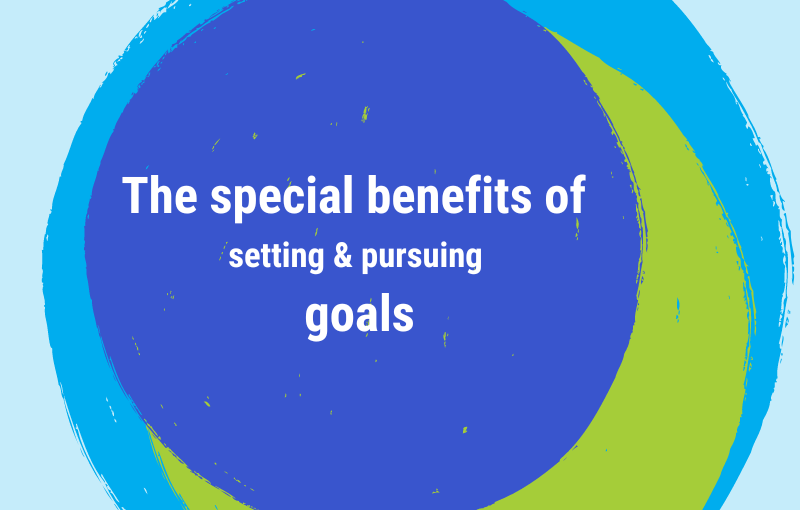Why setting goals and pursuing them is so important
The main reason why we usually decide to set goals for ourselves is, of course, because we want to achieve or get something that we currently don’t have in our life. Or maybe we want to change what currently is to something else – usually something better.
However, goal setting not only gets us on track to move towards our goals.
The special benefits of setting and pursuing goals
-
- The act of setting goals and then moving towards them has a deeper benefit:
It allows us to evolve and to develop our personal potential.
Moving towards something that’s beyond our current abilities and overcoming the obstacles on our way helps us to stretch ourselves and to become better in what we do and who we are.
-
- Another positive effect of setting and pursuing goals is that it gives our mind focus and direction.
If we don’t direct our mind, it runs on default. It might focus on thoughts that don’t benefit us – because they produce feelings and actions that create unwanted results in our life.
Our deliberate intentions and goals keep our mind from running ‘wild’, they provide supervision and structure and help us live our life on purpose.
The process of goal-setting – 6 tips that help you achieve what you want:
-
- Choose a goal – even if you don’t have one.
Even if you don’t have a specific goal at the moment, the act of setting a goal can be a really powerful and useful exercise.
It gives your mind and life focus and direction; it strengthens your motivation to realise your personal potential; it helps you get what you want. So, think about the different areas in your life and pick one you don’t feel happy about.
Now, choose a goal to help you make positive changes in the chosen area.
-
- Get specific but don’t think about the how yet.
Be very specific about your goal.
Talk about your goal in the first person and the present tense. Decide on time-frames, deadlines, and other details. However, don’t think about how you will achieve the goal yet.
For now, you focus on the what and when.
-
- Write the goal down.
Take your goal out of your imagination and make it real and tangible.
The best way to do this is to write it down. Writing down your goal on a piece of paper gets it out of your brain. You now can look at it, you can adjust it, you can carry it around, and you can (and should) read it again and again.
Your goal now acts like a GPS destination, indicating where you want to go.
-
- Stretch yourself with the goal, and ‘welcome’ any negative feelings.
Offer yourself a real self-development opportunity – make sure that you push yourself beyond your current comfort zone with your goal.
If it seems easy to achieve, it’s not a real goal! You will know you have stretched yourself sufficiently if negative emotions such as fear, doubt, or shame arise. Don’t push these feelings away; accept them as normal parts of the process.
Honouring and managing these feelings will not only ensure that you achieve your goal but also allow you to become a more robust and better version of yourself.
-
- Uncover any negative thoughts, and question/replace them.
Search for the negative thoughts that cause uncomfortable feelings.
It might be something like ‘This is too hard to do’, or ‘I don’t know how to do this’, or ‘I don’t know if this is what I want’. Uncover all the thoughts behind your feelings of disbelief or doubtfulness or fear – and write them down.
Then, remind yourself that these thoughts are just choices. Your human brain is bringing them up to protect you – it wants you to avoid any risks by keeping everything as it is – but that doesn’t mean you have to believe these limiting thoughts.
Tell your mind, ‘No worries – I’ll figure this out.’
-
- Have a brainstorming session with your future self to design an action plan.
When you are ready to start working on your action plan, you can ask your future self for help.
Imagine yourself at the place in the future when your goal has been completed. From that place, look back to where you are now, and you tell your present self the how – all the steps you took to accomplish the goal and what you did to overcome the obstacles on your way. Write these steps down; they build your action plan.
Now, you are ready to take the first action and work on achieving your goal!
With these tips, you can set new goals for your life that will help you start moving and creating the life you want to live.
The process of goal-setting – A personal example
Last year, I decided to improve my fitness levels. This is what my goal-setting looked like:
Tip 1 to 3 – Choose a goal, be specific, write it down
I want to increase my fitness levels by becoming a better runner. On my birthday – in 6 weeks’ time – I run from home to Bondi (across the suburbs) and then back home (along the coastal walk). That’s about 15 km and will take me about 2 hours.
Tip 4 – Stretch yourself and appreciate negative feelings
It’s a bold goal! Currently, I run for about 25 minutes two or three times a week. The idea to run around 2 hours without a break feels very intimidating and uncomfortable.
Tip 5 – Uncover negative thoughts and question/replace them
My original thoughts:
That’s a stupid idea. I am fit enough – why do I put this pressure on myself? I will hate myself if I don’t make it. And all the preparations and the training! I need to make a plan! And then stick to it! Oh no, this is really stupid – why do I always make my life difficult?!
My counter-thoughts:
O.k., o.k., calm down. It always feels great to achieve ambitious goals and this one will be no different. I’ll feel fantastic on my birthday, being so fit and strong. Yes, of course, it needs some time and effort to get prepared. Yes, I need to make a plan. But I am good at planning. I’ll make it work out!
Tip 6 – A brainstorming session with your future self
This is what I imagine my future self would say to me after the Bondi run:
I remember how uncomfortable I felt, 6 weeks ago, when I made this decision and wrote the goal down. It felt so intimidating to see my goal on paper.
But then I made a plan. I decided to change my running schedule to 4 times a week and to extend the running time to 40 minutes.
I also decided to do longer runs every Sunday: 45 minutes on the first Sunday (at the end of the first week), 50 minutes on the following Sunday, 60 minutes on the third and fourth Sunday, 90 minutes on the fifth Sunday (one week before the Bondi run).
I created a simple action plan, listing the running dates and running times.
I put the plan on the wall, opposite my desk, so that I had to look at it every day. And on all running days, I wrote ‘done!’ at the end of the line of that day as soon as I came home from running. That felt good!
I also remember, however, that it was not always fun, especially the longer runs on Sundays. But I never thought about giving up; that was just no option. I reminded myself that I did this for myself and that it was worth the effort.
Success! Goal achieved!
Eight weeks after I had set my goal, I did the Bondi run – it took me 1 hour and 50 minutes and was quite exhausting. But – I did it! The goal-setting process was very helpful, especially the ‘talks’ with my future self.

